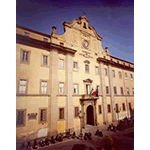Convitto Nazionale "Francesco Cicognini" ["Francesco Cicognini" National Boarding School]
Founded as a Jesuit boarding school in 1692, it began its teaching activity on the premises it still occupies today, inaugurated in 1715, under the direction of the grand-ducal architect Giovanni Battista Foggini. From 1773 to 1862, due to the suppression of the Society of Jesus decreed by Pope Clement XIV, the school was managed by secular priests, under the name of Imperial and Royal Boarding School. Between 1799 and 1812, during the French occupation, initiatives were undertaken to reform the institution. In 1859, subsequent to the Plebiscite that deposed Grand Duke Leopold II from sovereignty over Tuscany, the school became State property under the name of Reale Collegio Convitto [Royal Boarding School College], and was included in the national educational system. A Royal Decree of 1882 instituted the Regio Convitto Nazionale [Royal National Boarding School]. In 1950 it assumed its present name, in honour of the Canon Francesco Cicognini, thanks to whose legacy it had been instituted.
On the facade of the school is a circular glass quadrant with 12 Roman numerals in iron standing out in relief. Although the turret with the bells and the quadrant on the facade date from 1740, the present clockworks date from the first half of the 20th century, as stated on the plate on the horizontal frame: "Installed by the Icaro Gironi company – January 1932".
The School possesses a collection of about seventy instruments and educational models for the teaching of Physics and the Natural Sciences, most of them dating from the middle of the 20th century. Kept in the laboratories of physics and natural science, many of the instruments are still used today for teaching purposes. The historic scientific collection that belonged to the Boarding School is now found at the Liceo Classico "Cicognini" ["Cicognini" Classical Secondary School] in Prato.
****************************
Texts by Carlo Triarico
English translation by Catherine Frost
Last update 15/feb/2008




